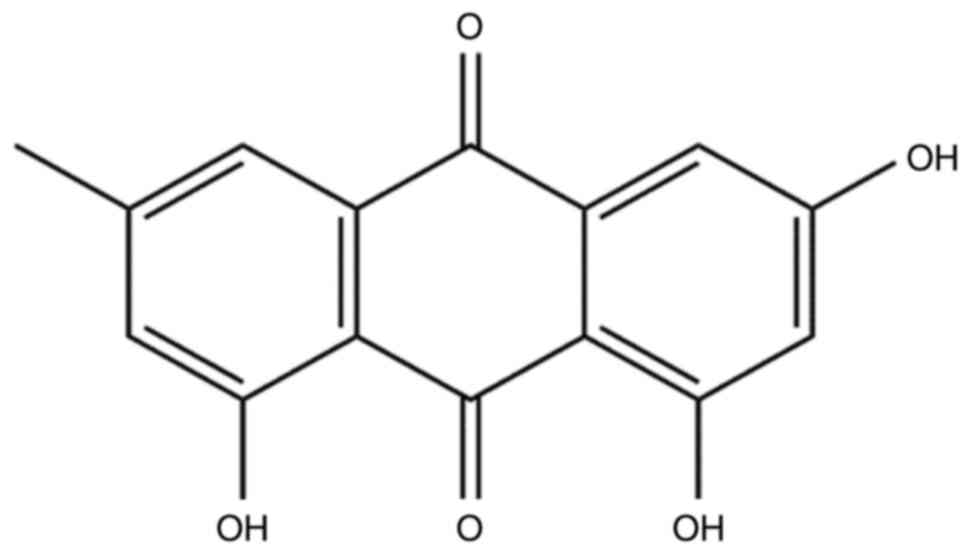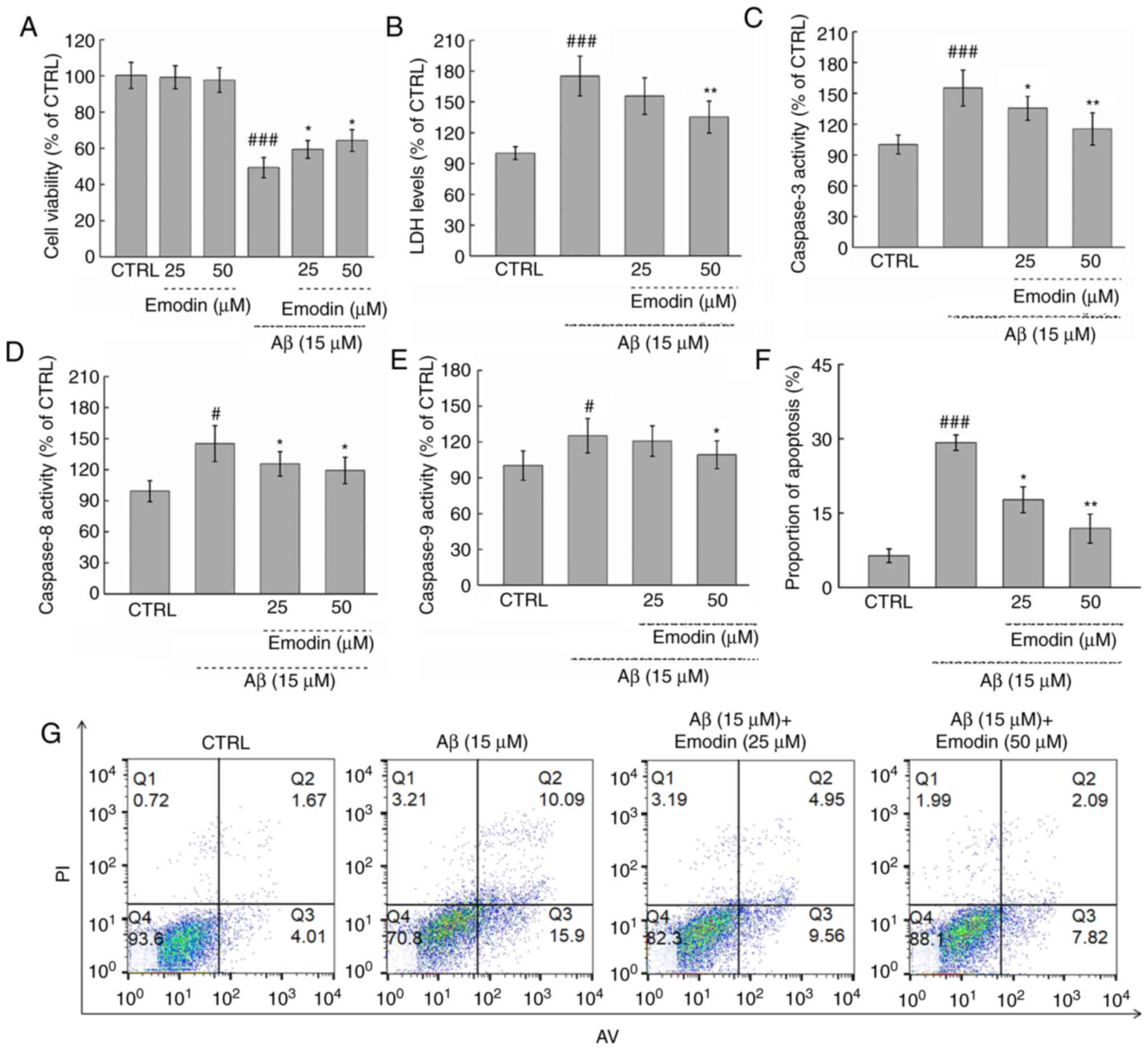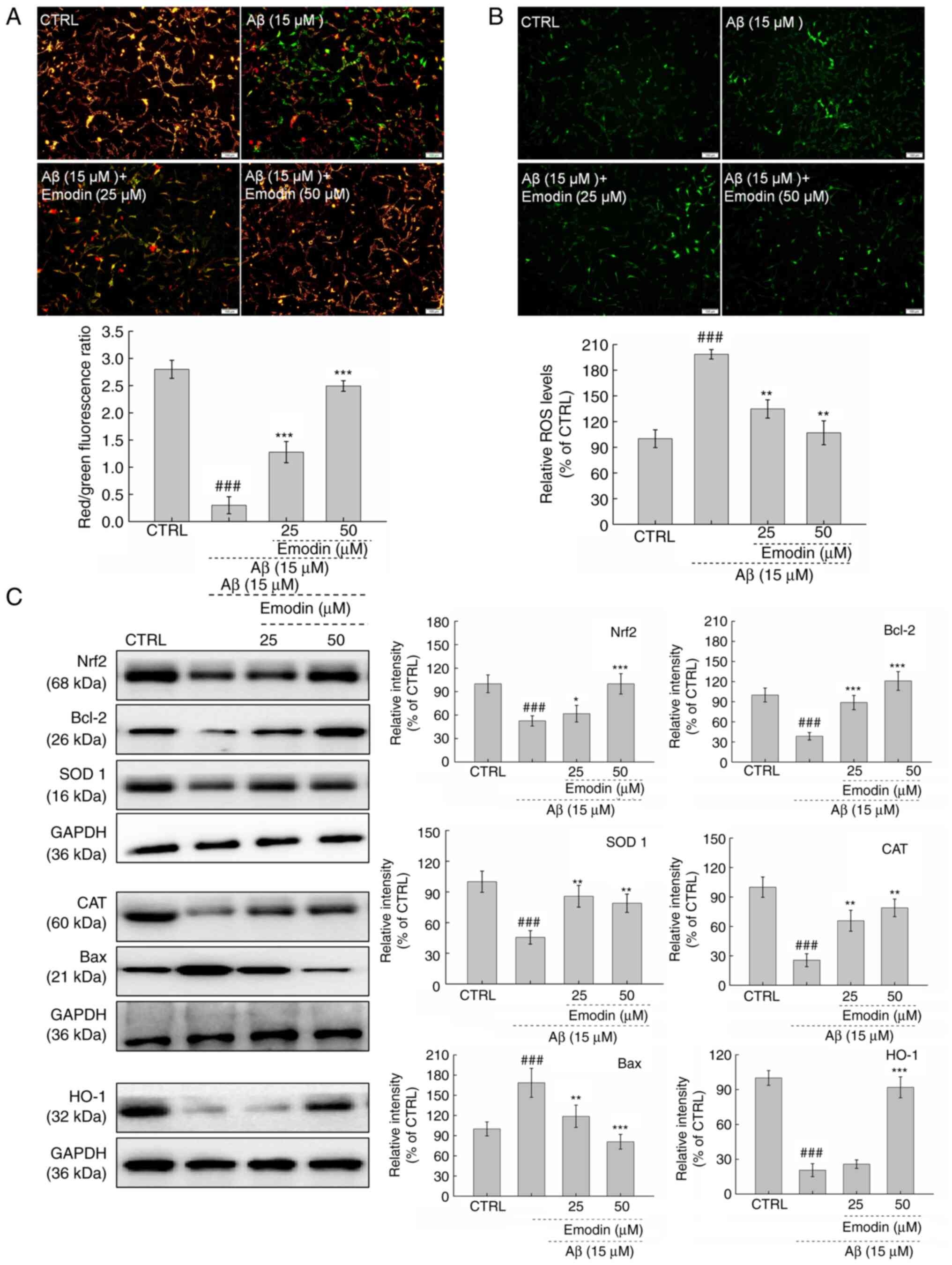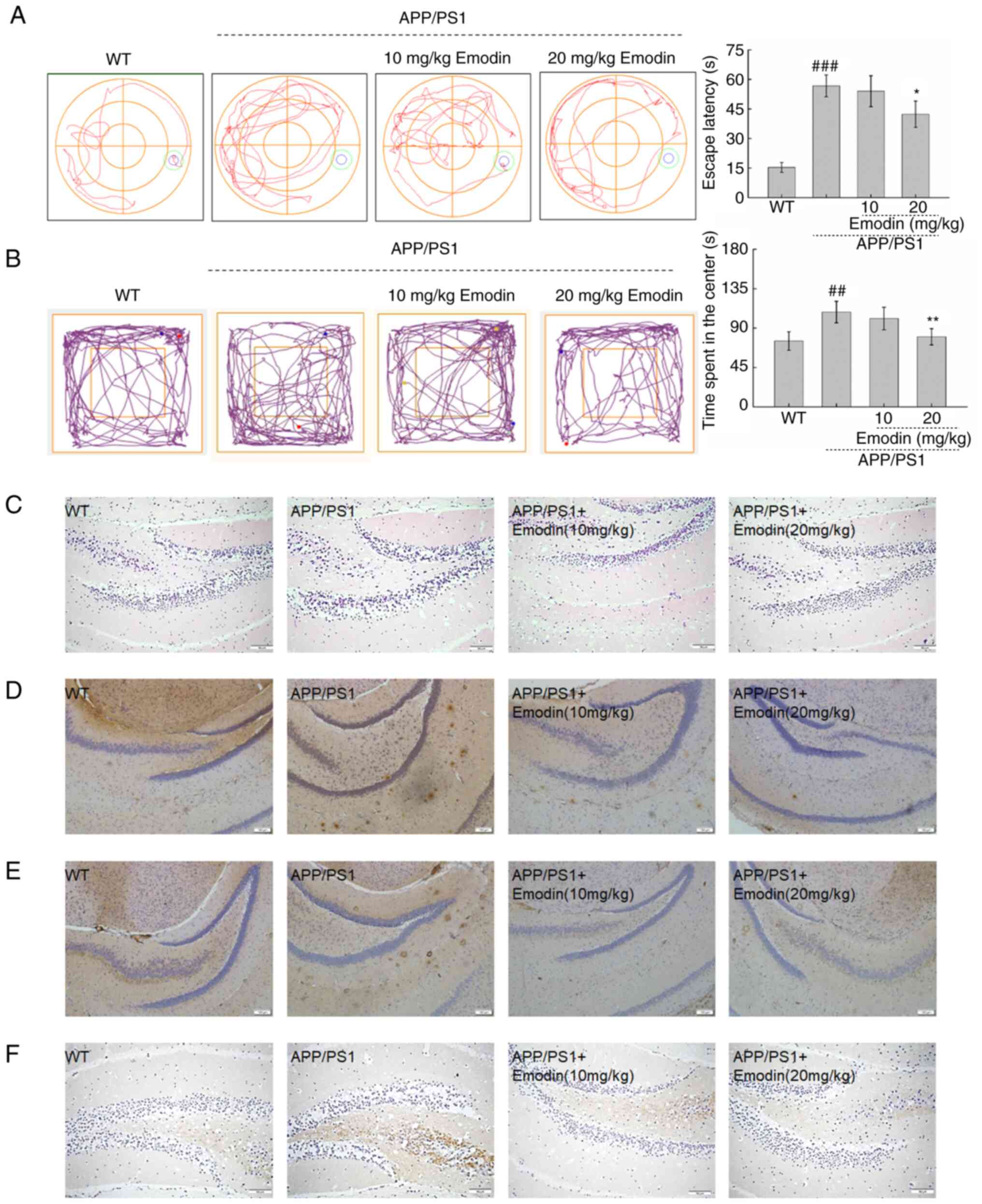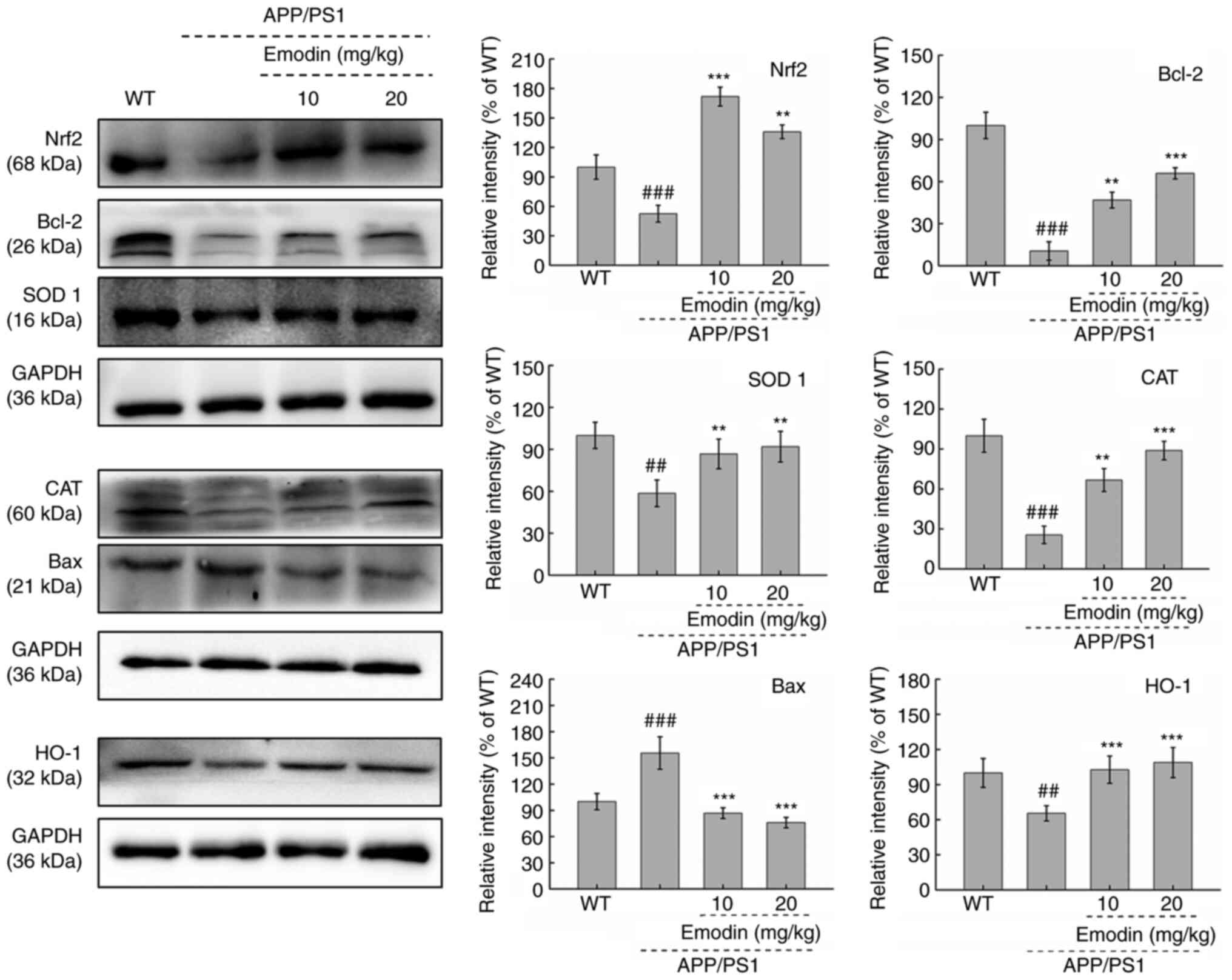|
1
|
Rygiel K and Rygiel K: Novel strategies
for Alzheimer's disease treatment: An overview of anti-amyloid beta
monoclonal antibodies. Indian J Pharmacol. 48:629–636. 2016.
View Article : Google Scholar
|
|
2
|
Viña J, Lloret A, Giraldo E, Badia MC and
Alonso MD: Antioxidant pathways in Alzheimers disease:
Possibilities of intervention. Curr Pharm Des. 17:3861–3864. 2011.
View Article : Google Scholar
|
|
3
|
Evans DA, Beckett LA, Field TS, Feng L,
Albert MS, Bennett DA, Tycko B and Mayeux R: Apolipoprotein E
epsilon4 and incidence of Alzheimer disease in a community
population of older persons. JAMA. 277:822–824. 1997. View Article : Google Scholar
|
|
4
|
Faizi M, Seydi E, Abarghuyi S, Salimi A,
Nasoohi S and Pourahmad J: A Search for Mitochondrial Damage in
Alzheimer's Disease Using Isolated Rat Brain Mitochondria. Iran J
Pharm Res. 15 (Suppl):185–195. 2016.
|
|
5
|
Chen Z and Zhong C: Oxidative stress in
Alzheimer's disease. Neurosci Bull. 30:271–281. 2014. View Article : Google Scholar
|
|
6
|
Ahmad W, Ijaz B, Shabbiri K, Ahmed F and
Rehman S: Oxidative toxicity in diabetes and Alzheimer's disease:
Mechanisms behind ROS/ RNS generation. J Biomed Sci. 24:762017.
View Article : Google Scholar
|
|
7
|
Angelova PR and Abramov AY: Role of
mitochondrial ROS in the brain: From physiology to
neurodegeneration. FEBS Lett. 592:692–702. 2018. View Article : Google Scholar
|
|
8
|
Nesi G, Sestito S, Digiacomo M and
Rapposelli S: Oxidative Stress, Mitochondrial Abnormalities and
Proteins Deposition: Multitarget Approaches in Alzheimer's Disease.
Curr Top Med Chem. 17:3062–3079. 2017.
|
|
9
|
Hardy J: Alzheimer's disease: The amyloid
cascade hypothesis: an update and reappraisal. J Alzheimers Dis. 9
(Suppl. 3):151–153. 2006. View Article : Google Scholar
|
|
10
|
Kang MI, Kobayashi A, Wakabayashi N, Kim
SG and Yamamoto M: Scaffolding of Keap1 to the actin cytoskeleton
controls the function of Nrf2 as key regulator of cytoprotective
phase 2 genes. Proc Natl Acad Sci USA. 101:2046–2051. 2004.
View Article : Google Scholar
|
|
11
|
Kaur SJ, McKeown SR and Rashid S: Mutant
SOD1 mediated pathogenesis of Amyotrophic Lateral Sclerosis. Gene.
577:109–118. 2016. View Article : Google Scholar
|
|
12
|
Kensler TW, Wakabayashi N and Biswal S:
Cell survival responses to environmental stresses via the
Keap1-Nrf2-ARE pathway. Annu Rev Pharmacol Toxicol. 47:89–116.
2007. View Article : Google Scholar
|
|
13
|
Kärkkäinen V, Pomeshchik Y, Savchenko E,
Dhungana H, Kurronen A, Lehtonen S, Naumenko N, Tavi P, Levonen AL,
Yamamoto M, et al: Nrf2 regulates neurogenesis and protects neural
progenitor cells against Aβ toxicity. Stem Cells. 32:1904–1916.
2014. View Article : Google Scholar
|
|
14
|
Calkins MJ, Johnson DA, Townsend JA,
Vargas MR, Dowell JA, Williamson TP, Kraft AD, Lee JM, Li J and
Johnson JA: The Nrf2/ARE pathway as a potential therapeutic target
in neurodegenerative disease. Antioxid Redox Signal. 11:497–508.
2009. View Article : Google Scholar
|
|
15
|
Wang JB, Zhao HP, Zhao YL, Jin C, Liu DJ,
Kong WJ, Fang F, Zhang L, Wang HJ and Xiao XH: Hepatotoxicity or
hepatoprotection? Pattern recognition for the paradoxical effect of
the Chinese herb Rheum palmatum L. in treating rat liver
injury. PLoS One. 6:e244982011. View Article : Google Scholar
|
|
16
|
Yang YC, Lim M-Y and Lee H-S: Emodin
isolated from Cassia obtusifolia (Leguminosae) seed shows
larvicidal activity against three mosquito species. J Agric Food
Chem. 51:7629–7631. 2003. View Article : Google Scholar
|
|
17
|
Lee MH, Kao L and Lin C-C: Comparison of
the antioxidant and transmembrane permeative activities of the
different Polygonum cuspidatum extracts in
phospholipid-based microemulsions. J Agric Food Chem. 59:9135–9141.
2011. View Article : Google Scholar
|
|
18
|
Dong X, Fu J, Yin X, Cao S, Li X, Lin L,
Ni J and Emodin: A Review of its Pharmacology, Toxicity and
Pharmacokinetics. Phytother Res. 30:1207–1218. 2016. View Article : Google Scholar
|
|
19
|
Liu T, Jin H, Sun QR, Xu JH and Hu HT:
Neuroprotective effects of emodin in rat cortical neurons against
beta-amyloid-induced neurotoxicity. Brain Res. 1347:149–160. 2010.
View Article : Google Scholar
|
|
20
|
Lin J, Ma C and Lin HH: Emodin Alleviates
Viral Myocarditis in BALB/c Mice and Underlying Mechanisms. Lat Am
J Pharm. 38:1979–1984. 2019.
|
|
21
|
Park SY, Jin ML, Ko MJ, Park G and Choi
YW: Anti-neuroinflammatory Effect of Emodin in LPS-Stimulated
Microglia: Involvement of AMPK/Nrf2 Activation. Neurochem Res.
41:2981–2992. 2016. View Article : Google Scholar
|
|
22
|
Tian SL, Yang Y, Liu XL and Xu QB: Emodin
Attenuates Bleomycin-Induced Pulmonary Fibrosis via
Anti-Inflammatory and Anti-Oxidative Activities in Rats. Med Sci
Monit. 24:1–10. 2018. View Article : Google Scholar
|
|
23
|
Mizuno M, Kawamura H, Takei N and Nawa H:
The anthraquinone derivative Emodin ameliorates neurobehavioral
deficits of a rodent model for schizophrenia. J Neural Transm
(Vienna). 115:521–530. 2008. View Article : Google Scholar
|
|
24
|
Li Z, Chen X, Zhang Y, Liu X, Wang C, Teng
L and Wang D: Protective roles of Amanita caesarea polysaccharides
against Alzheimer's disease via Nrf2 pathway. Int J Biol Macromol.
121:29–37. 2019. View Article : Google Scholar
|
|
25
|
Han Y, Nan S, Fan J, Chen Q and Zhang Y:
Inonotus obliquus polysaccharides protect against Alzheimer's
disease by regulating Nrf2 signaling and exerting antioxidative and
antiapoptotic effects. Int J Biol Macromol. 131:769–778. 2019.
View Article : Google Scholar
|
|
26
|
Zhang Y, Wang J, Wang C, Li Z, Liu X,
Zhang J, Lu J and Wang D: Pharmacological Basis for the Use of
Evodiamine in Alzheimer's Disease: Antioxidation and Antiapoptosis.
Int J Mol Sci. 19:192018.
|
|
27
|
Sharifi AM, Eslami H, Larijani B and
Davoodi J: Involvement of caspase-8, −9, and −3 in high
glucose-induced apoptosis in PC12 cells. Neurosci Lett. 459:47–51.
2009. View Article : Google Scholar
|
|
28
|
Berry BJ, Trewin AJ, Amitrano AM, Kim M
and Wojtovich AP: Use the Protonmotive Force: Mitochondrial
Uncoupling and Reactive Oxygen Species. J Mol Biol. 430:3873–3891.
2018. View Article : Google Scholar
|
|
29
|
Tan S, Sagara Y, Liu Y, Maher P and
Schubert D: The regulation of reactive oxygen species production
during programmed cell death. J Cell Biol. 141:1423–1432. 1998.
View Article : Google Scholar
|
|
30
|
Grivennikova VG and Vinogradov AD:
Generation of superoxide by the mitochondrial Complex I. Biochim
Biophys Acta. 1757:553–561. 2006. View Article : Google Scholar
|
|
31
|
Reed JC, Jurgensmeier JM and Matsuyama S:
Bcl-2 family proteins and mitochondria. Biochim Biophys Acta.
1366:127–137. 1998. View Article : Google Scholar
|
|
32
|
McMahon M, Itoh K, Yamamoto M, Chanas SA,
Henderson CJ, McLellan LI, Wolf CR, Cavin C and Hayes JD: The
Cap'n'Collar basic leucine zipper transcription factor Nrf2 (NF-E2
p45-related factor 2) controls both constitutive and inducible
expression of intestinal detoxification and glutathione
biosynthetic enzymes. Cancer Res. 61:3299–3307. 2001.
|
|
33
|
Benedict C: Candidate mechanisms
underlying the association between poor sleep and obesity.
Endocrine Abstracts. 49:pp. S282017, simplehttps://doi.org/10.1530/endoabs.49.S28.1
|
|
34
|
Choi ML and Gandhi S: Crucial role of
protein oligomerization in the pathogenesis of Alzheimer's and
Parkinson's diseases. FEBS J. 285:3631–3644. 2018. View Article : Google Scholar
|
|
35
|
Ansari MA and Scheff SW: Oxidative stress
in the progression of Alzheimer disease in the frontal cortex. J
Neuropathol Exp Neurol. 69:155–167. 2010. View Article : Google Scholar
|
|
36
|
Selkoe DJ: Alzheimer's disease: Genes,
proteins, and therapy. Physiol Rev. 81:741–766. 2001. View Article : Google Scholar
|
|
37
|
Saxena G, Singh SP, Agrawal R and Nath C:
Effect of donepezil and tacrine on oxidative stress in
intracerebral streptozotocin-induced model of dementia in mice. Eur
J Pharmacol. 581:283–289. 2008. View Article : Google Scholar
|
|
38
|
Monisha BA, Kumar N and Tiku AB: Emodin
and Its Role in Chronic Diseases. Adv Exp Med Biol. 928:47–73.
2016. View Article : Google Scholar
|
|
39
|
Handattu SP, Monroe CE, Nayyar G,
Palgunachari MN, Kadish I, van Groen T, Anantharamaiah GM and
Garber DW: In vivo and in vitro effects of an apolipoprotein E
mimetic peptide on amyloid-β pathology. J Alzheimers Dis.
36:335–347. 2013. View Article : Google Scholar
|
|
40
|
Carrillo-Mora P, Luna R and Colín-Barenque
L: Amyloid beta: Multiple mechanisms of toxicity and only some
protective effects? Oxid Med Cell Longev. 2014:7953752014.
View Article : Google Scholar
|
|
41
|
Anandatheerthavarada HK, Biswas G, Robin
M-A and Avadhani NG: Mitochondrial targeting and a novel
transmembrane arrest of Alzheimer's amyloid precursor protein
impairs mitochondrial function in neuronal cells. J Cell Biol.
161:41–54. 2003. View Article : Google Scholar
|
|
42
|
Pluta R, Ułamek-Kozioł M and Czuczwar SJ:
Neuroprotective and Neurological/Cognitive Enhancement Effects of
Curcumin after Brain Ischemia Injury with Alzheimer's Disease
Phenotype. Int J Mol Sci. 19:40022018. View Article : Google Scholar
|
|
43
|
Viswanath V, Wu Y, Boonplueang R, Chen S,
Stevenson FF, Yantiri F, Yang L, Beal MF and Andersen JK: Caspase-9
activation results in downstream caspase-8 activation and bid
cleavage in 1-methyl-4-phenyl-1,2,3,6-tetrahydropyridine-induced
Parkinson's disease. J Neurosci. 21:9519–9528. 2001. View Article : Google Scholar
|
|
44
|
Cain K, Bratton SB, Langlais C, Walker G,
Brown DG, Sun XM and Cohen GM: Apaf-1 oligomerizes into
biologically active approximately 700-kDa and inactive
approximately 1.4-MDa apoptosome complexes. J Biol Chem.
275:6067–6070. 2000. View Article : Google Scholar
|
|
45
|
Luca M, Luca A and Calandra C: The Role of
Oxidative Damage in the Pathogenesis and Progression of Alzheimer's
Disease and Vascular Dementia. Oxid Med Cell Longev.
2015:5046782015. View Article : Google Scholar
|
|
46
|
Casley CS, Canevari L, Land JM, Clark JB
and Sharpe MA: Beta-amyloid inhibits integrated mitochondrial
respiration and key enzyme activities. J Neurochem. 80:91–100.
2002. View Article : Google Scholar
|
|
47
|
Gross A, McDonnell JM and Korsmeyer SJ:
BCL-2 family members and the mitochondria in apoptosis. Genes Dev.
13:1899–1911. 1999. View Article : Google Scholar
|
|
48
|
Zhu W, Cowie A, Wasfy GW, Penn LZ, Leber B
and Andrews DW: Bcl-2 mutants with restricted subcellular location
reveal spatially distinct pathways for apoptosis in different cell
types. EMBO J. 15:4130–4141. 1996. View Article : Google Scholar
|
|
49
|
Hsu YT and Youle RJ: Nonionic detergents
induce dimerization among members of the Bcl-2 family. J Biol Chem.
272:13829–13834. 1997. View Article : Google Scholar
|
|
50
|
Itoh K, Wakabayashi N, Katoh Y, Ishii T,
Igarashi K, Engel JD and Yamamoto M: Keap1 represses nuclear
activation of antioxidant responsive elements by Nrf2 through
binding to the amino-terminal Neh2 domain. Genes Dev. 13:76–86.
1999. View Article : Google Scholar
|
|
51
|
Zhang Y, Unnikrishnan A, Deepa SS, Liu Y,
Li Y, Ikeno Y, Sosnowska D, Van Remmen H and Richardson A: A new
role for oxidative stress in aging: The accelerated aging phenotype
in Sod1−/− mice is correlated to increased cellular
senescence. Redox Biol. 11:30–37. 2017. View Article : Google Scholar
|
|
52
|
Kansanen E, Kuosmanen SM, Leinonen H and
Levonen AL: The Keap1-Nrf2 pathway: Mechanisms of activation and
dysregulation in cancer. Redox Biol. 1:45–49. 2013. View Article : Google Scholar
|
|
53
|
Dinkova-Kostova AT and Abramov AY: The
emerging role of Nrf2 in mitochondrial function. Free Radic Biol
Med. 88B:B179–B188. 2015. View Article : Google Scholar
|
|
54
|
Rojo AI, Pajares M, Rada P, Nuñez A,
Nevado-Holgado AJ, Killik R, Van Leuven F, Ribe E, Lovestone S,
Yamamoto M, et al: NRF2 deficiency replicates transcriptomic
changes in Alzheimer's patients and worsens APP and TAU pathology.
Redox Biol. 13:444–451. 2017. View Article : Google Scholar
|
|
55
|
Hu D, Serrano F, Oury TD, Klann E and Hu
D: Aging-dependent alterations in synaptic plasticity and memory in
mice that overexpress extracellular superoxide dismutase. J
Neurosci. 26:3933–3941. 2006. View Article : Google Scholar
|
|
56
|
Pietrzak RH, Lim YY, Neumeister A, Ames D,
Ellis KA, Harrington K, Lautenschlager NT, Restrepo C, Martins RN,
Masters CL, et al Australian Imaging, Biomarkers, Lifestyle
Research Group, : Amyloid-β, anxiety, and cognitive decline in
preclinical Alzheimer disease: A multicenter, prospective cohort
study. JAMA Psychiatry. 72:284–291. 2015. View Article : Google Scholar
|
|
57
|
Delatour B, Guégan M, Volk A and Dhenain
M: In vivo MRI and histological evaluation of brain atrophy in
APP/PS1 transgenic mice. Neurobiol Aging. 27:835–847. 2006.
View Article : Google Scholar
|
|
58
|
Mehta MA: Morris Water Maze. Encyclopedia
of Psychopharmacology. Stolerman IP: Springer; Berlin, Heidelberg:
2010, simplehttps://doi.org/10.1007/978-3-540-68706-1_1638
|
|
59
|
Prut L and Belzung C: The open field as a
paradigm to measure the effects of drugs on anxiety-like behaviors:
A review. Eur J Pharmacol. 463:3–33. 2003. View Article : Google Scholar
|
|
60
|
Kamat PK, Kalani A, Rai S, Swarnkar S,
Tota S, Nath C and Tyagi N: Mechanism of Oxidative Stress and
Synapse Dysfunction in the Pathogenesis of Alzheimer's Disease:
Understanding the Therapeutics Strategies. Mol Neurobiol.
53:648–661. 2016. View Article : Google Scholar
|
|
61
|
Leroy K, Ando K, Laporte V, Dedecker R,
Suain V, Authelet M, Héraud C, Pierrot N, Yilmaz Z, Octave JN, et
al: Lack of tau proteins rescues neuronal cell death and decreases
amyloidogenic processing of APP in APP/PS1 mice. Am J Pathol.
181:1928–1940. 2012. View Article : Google Scholar
|
|
62
|
Stamer K, Vogel R, Thies E, Mandelkow E
and Mandelkow EM: Tau blocks traffic of organelles, neurofilaments,
and APP vesicles in neurons and enhances oxidative stress. J Cell
Biol. 156:1051–1063. 2002. View Article : Google Scholar
|
|
63
|
Smith MA, Hirai K, Hsiao K, Pappolla MA,
Harris PL, Siedlak SL, Tabaton M and Perry G: Amyloid-beta
deposition in Alzheimer transgenic mice is associated with
oxidative stress. J Neurochem. 70:2212–2215. 1998. View Article : Google Scholar
|
|
64
|
Wirths O, Multhaup G, Czech C, Feldmann N,
Blanchard V, Tremp G, Beyreuther K, Pradier L and Bayer TA:
Intraneuronal APP/A beta trafficking and plaque formation in
beta-amyloid precursor protein and presenilin-1 transgenic mice.
Brain Pathol. 12:275–286. 2002. View Article : Google Scholar
|















